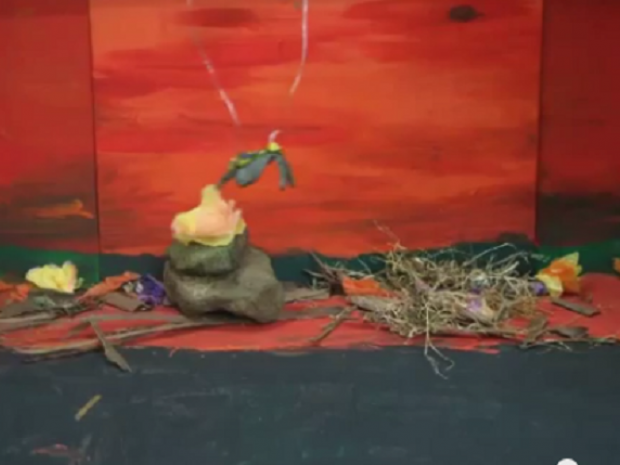Visual Arts - Highlights of 2014

Last year (2014) the senior students created amazing Claymation Projects about the Seven Seasons of the Kulin People, springing from their experiences with Murrindindi, local Aboriginal elder, at school. Their experience brought together design, creativity, collaboration and presentation. Please view their projects below.
With assistance, the junior class researched and then wrote these narrations for their short plays describing the Kulin Seasons. Murrindindi also assisted us in understanding how each season was mainly determined by shifting food sources (see writing below each movie).
The junior students also made stunning multi-media, three dimensional paintings about the Kulin seasons. Then wrote short statements about their work which was then turned into a flip book for their enjoyment.
It is hot and dry. The temperature continues to rise. There is hardly any rain. The bowat - tussock grass - is so long that the children run around playing hidey. Watch out for snakes! The female common butterflies fly around fluttering from flower to flower. The southern cross is high in the south at sunrise.
The hot winds have stopped and the temperatures are cooling. The eels scurry and flurry in the water. They dip and dive. They swim fast and slow in the water. The kulin people set a fishing line at night time, in the lagoons. The eels are fat and ready to catch. The manna gum is flowering. The days and nights are as short as each other. Lo-An Tuka the hunter star is seen in the south at sunset.
Cool rainy days follow misty mornings. This is the time of the highest annual rainfall. The wombat emerges from its burrow. It grazes in the sunshine. The Kulin people would hunt the wombat, the pig and echidna, having a tasty meal, saying they all taste the same. The bulen-bulen perform their courtship ritual, displaying the superb feathery tail. The hearts of the Kombadik or tree-fern are the major source of food when no fruits are available. They untwirl and form a soft crown. The days are short and the nights are long. This is the midpoint of cold weather – the winter solstice.
Cold weather is coming to an end. Guling (orchids) are flowering. Ae-noke (caterpillars) of Common Brown butterfly feed on grasses at night. Muyan (Silver Wattles) are flowering. Bulen-bulen (Superb Lyrebird) males perform the last of their courtship displays. The star Arcturus is seen on the north-western horizon soon after sunset. Gurrborra (Koalas) begin mating. Males bellow at night.
The temperature is rising, the rain continues to fall. The flax lilies are flowering. This is our food. The Kulin people caught frogs and tied their legs together and put them on a hook – catching cod-fish that way was good. The Pied Currawong bird calls loudly and often. She flies gently across the sky calling as she flies. She calls like the Bulen-Bulen. But the Bulen-Bulen copies her sound. It is hard to know who is calling! The males have stopped their calling. The day and night are as long as each other.
The weather is warm, it is often raining, the kangaroo grass and Christmas bush are flowering. At night the bats are active, chasing the insects through the sky. They fly and swoop and chase. For the Kulin people, the food at this time of year was the seeds of the Christmas bush, which was ground down into flour like making damper. The butterflies came down to the flowers a lot at this time. But in the night the bats keep swooping. The Orion constellation can be seen in the western sky about sunrise.
The duhling (goannas) are very active. They skulk and skim. The storm is coming, rain birds, black cockatoos, yellow crested all come down from the mountains. Then it will rain. The birds keep calling. Fruits appear on the kangaroo apple bushes. Bunjil is breeding. He is called the eagle hawk. He soars high above the ground, then after they watch, they swoop, sometimes catching a kangaroo! The Kulin people eat the fruits of the kangaroo apple and the native cherry.
In Visual Arts this year (2015) we will be working on a project called ‘My Place’. All students will be encouraged to explore their family heritage and create a unique piece of art. We will explore different art forms through time, including indigenous art forms, and integrate these understandings into their projects.
Following on from the wonderful experience of the 2014 Open Door Community Church Art Show, all students will again be given opportunity to enter works in this years show. Please view the students efforts here.

